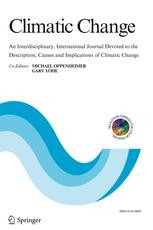Climate change could mean more weight restrictions and higher costs for airlines
Researchers use model to calculate how increased air temperatures due to climate change will affect aviation operations around the world
Heidelberg | New York, 13 July 2017
 As air temperatures rise at constant pressure, the density of air declines and this makes it harder for an airplane to take off. Increased air temperatures due to climate change could therefore present a new challenge for the aviation industry. This is according to Ethan Coffel of Columbia University in the US, lead author of a study in Climatic Change Letters which is a section in Springer’s journal Climatic Change.
As air temperatures rise at constant pressure, the density of air declines and this makes it harder for an airplane to take off. Increased air temperatures due to climate change could therefore present a new challenge for the aviation industry. This is according to Ethan Coffel of Columbia University in the US, lead author of a study in Climatic Change Letters which is a section in Springer’s journal Climatic Change.
Together with his co-authors he investigated how rising temperatures will mean increased weight restrictions on a significant number of flights, potentially imposing increased costs on the aviation industry in the next century.
According to climate change projections, the annual maximum temperatures at airports worldwide could increase by four to eight degrees Celsius by 2080. Air temperature has an important effect on aircraft takeoff performance. For a given runway or aircraft there is a temperature threshold above which an aircraft cannot take off at its maximum weight, requiring a weight restriction – removing passengers, cargo or fuel.
Coffel and his colleagues developed a model to project future weight-restrictions across a fleet of aircraft with different takeoff weights operating at a variety of airports. They constructed performance models for five commercial aircraft (the Boeing 737-800, Airbus A320, Boeing 787-8, Boeing 777-300, and Airbus A380) at 19 major airports in different temperature zones and elevations worldwide. They included projections of daily temperatures from a climate model suite known as CMIP5 under two carbon emissions scenarios to calculate possible weight restrictions that might be required at these airports during a day.
“This work is an advancement of our research from 2015 which focused on four US airports, one common aircraft type, and considered only changes in the frequency of certain levels of weight restriction,” explains Coffel.
In this research the researchers found that from 2050 onwards, on average five to twenty-five percent of flights departing during the warmest hour of the day may require some weight restriction below their maximum takeoff weights. These restrictions could total between 0.5 and 4% of total aircraft payload capacity in the worst cases.
“Both mid-sized and large aircraft are affected, and airports with short runways and high temperatures, or those at high elevations, will see the largest impacts,” explains Coffel.
“Our results suggest that weight restriction may impose a non-trivial cost on airlines and impact aviation operations around the world,” says Coffel. “The sooner climate change is incorporated into mid- and long-range plans the more effective adaptation efforts can be.”
Such adaptations could include changes in aircraft design, scheduling changes or building longer runways.
Reference: Coffel, E.D. et al (2017). The impacts of rising temperatures on aircraft takeoff performance, Climatic Change Letters DOI 10.1007/s10584-017-2018-9
Further Information
About the journal Climatic Change and Climatic Change Letters
Services for Journalists
The full-text article is available to journalists on request.
Contact
Elizabeth Hawkins | Springer Nature | Communications
tel +49 6221 487 8130 | elizabeth.hawkins@springer.com
For further information about the study please contact
Dr. Radley Horton, +1 (646) 320-9938 rh142@columbia.edu
